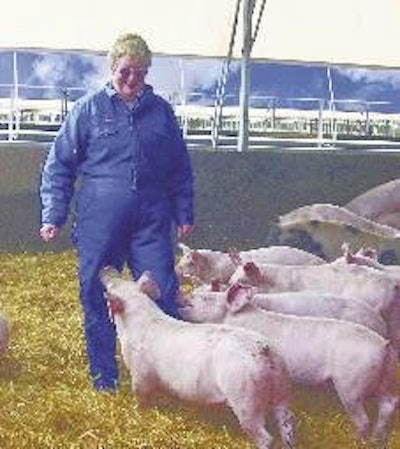
Water matters a great deal when you operate in the world's driest continent. So it should be no surprise that attempts in Australia at analysing the inputs for agribusiness products have been particularly interested in water use.
In 2008, industry body Australian Pork Ltd will be completing a so-called life-cycle analysis or LCA of pig production, in which the usage of water will be a key point. Similar analyses have already been completed on behalf of the dairy, beef and grain industries, while Australian wine producers are participating in an international version covering grape culture.
Even now, some figures compiled in Australia indicate that producing pigs makes more effective use of scarce water resources than various other farming systems. A report in Australian journal WME Magazine quotes estimates from national research bureau ABARE for the financial return realised from each million litres required by an agribusiness enterprise. The figure for product value at farmgate prices per megalitre (ML) are said to range from A$400 for rice to A$700 for beef, sheep, cotton and sugar, whereas aquaculture is reckoned to earn up to A$120,000.
A report in Australian journal WME Magazine quotes estimates from national research bureau ABARE for the financial return realised from each thousand litres required by an agribusiness enterprise. The figure for earnings per ML are said to range from A$400 for rice to A$700 for beef and sheep, whereas aquaculture is reckoned to earn as much as A$120 000.
Note therefore the earnings per ML attributed by the WME report to one particular pig unit in Victoria, Australia. Trading as The Pig Pen and operated by Claire Penniceard, this is reckoned to make A$650 000 per ML of water. It is due partly to the animal, says the WME report. Monogastrics are far better than ruminants at feed efficiency. While it takes 8.5kg of grain-based feed to put a kilogram of meat on an average 65kg lamb in lot-fed situations, less than 2.5kg is needed for adding 1kg to a 100kg pig.
Other contributors to the comparatively low water requirement are listed to include the use of a highly integrated and efficient feedlot system. The reference here is to Claire Penniceard's development of an enterprise in the Euroa area of northern Victoria over the past 7 years that now produces 28 000 pigs per year for export to Singapore from deep-bedded ecoshelters. A fundamental factor has been her desire to take sustainability to the maximum possible and to produce pigs with the smallest possible environmental footprint.
"An enterprise is not truly sustainable unless it can be repeated indefinitely," she declared to WME editor Richard Collins. "As soon as you need top-ups from outside to keep the business going, you are no longer sustainable."
When produced efficiently, she adds, pigs come out on top in most metrics of sustainable livestock production, from kilos of grain or feed per kilogram of meat produced to revenue per megalitre of water.According to the average rainfall recorded for the Euroa area, a block of land measuring only 48 metres x 30 metres would have been enough to receive the 4 megalitres of water that industry data suggested were needed for each of her 2 new pig production sites. Obviously this area would be far too small for producing pigs commercially, so she bought a block amounting to 250m x 250m or about 6.25 hectares. Each of these sites can harvest 34 megalitres of water per year.
Water quality is tested regularly at a laboratory in Victoria authorised to undertake the checks. The unit has established dual water sources from the town system and local extraction to guarantee continuity of supply and make it entirely independent of rainfall, all of which is therefore contributed to the environment. Rainwater trapped behind a dam on the property is made available to the Country Fire Association to take all it needs, a valuable social service in rural Australia.
Water and energy use at The Pig Pen are minimised by having open sheds in which a novel misting system helps to keep the pigs cool. Supplies from both water sources for the enterprise are piped directly into tanks and taken from there to the mister-cooler lines and drinkers in the piggery, leaving no part of the supply line open to contamination.
Nothing is discharged from the sites. Manure and straw become a valuable mulch, capable of regenerating the soil of 3500ha of land each year. Claire is also evaluating an unusual form of bedding in her ecoshelters. Instead of cereal straw, she has tried a waste product from wine growing for possible use in deep-litter systems. It is known as grape marc and consists of the residue of skins and seeds left after grapes are pressed for wine. Although problematic to wine growers, it is thought in Australia to have high promise as an increasingly important bedding material. In a country that has been hit by successive droughts, conventional straw has joined water in becoming a resource that is less available and more expensive.PIGI















